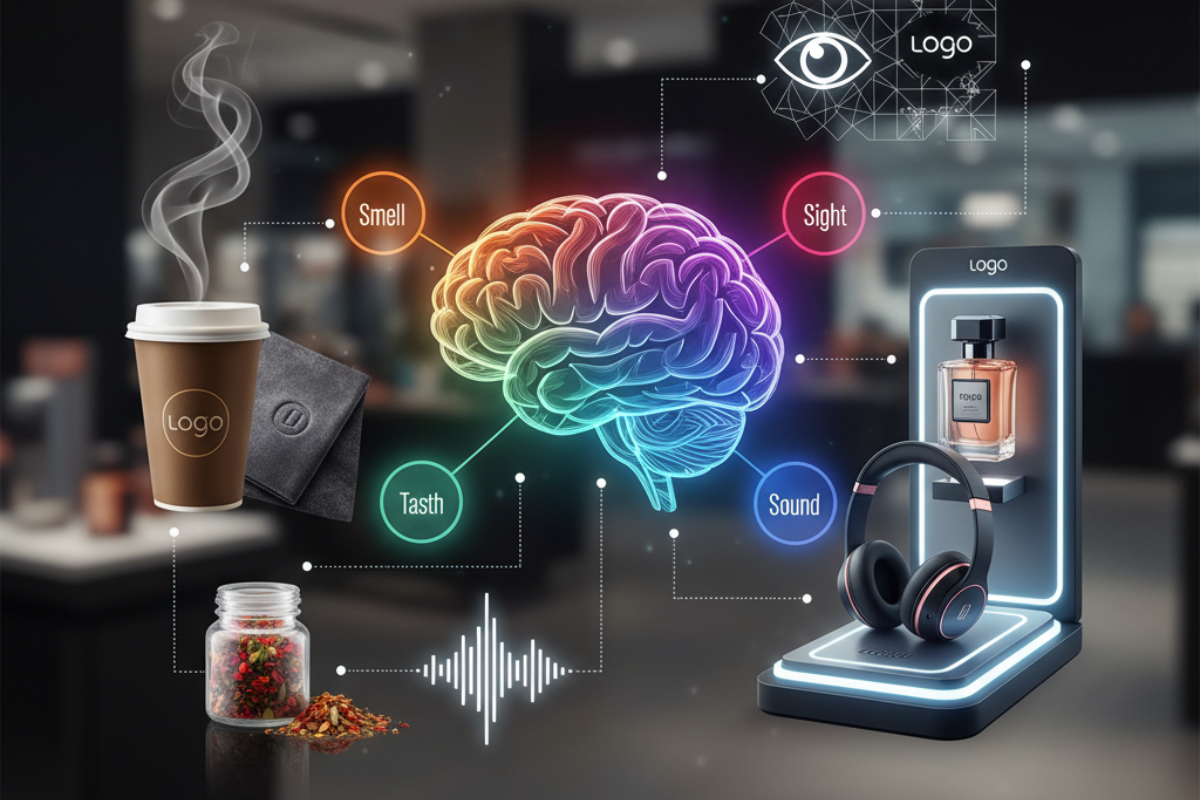Sensory Branding: Engaging All Five Senses to Create Unforgettable Brand Experiences

In today’s competitive market, brands need more than logos, colors, or slogans to stand out. Sensory branding creates immersive experiences that connect with customers on a deeper, emotional level. By engaging all five human senses—sight, sound, smell, touch, and taste—brands can deliver memorable brand experiences, boost customer engagement, and build emotional loyalty. This approach helps your business differentiate from competitors while strengthening brand perception and increasing brand equity.
This guide explores how to implement sensory branding, integrate each sense effectively, and measure its impact on overall consumer experience.
What is Sensory Branding?

Sensory branding, or multi-sensory or experiential branding, strategically uses visual, auditory, olfactory, tactile, and gustatory cues to shape consumer perceptions and influence behavior. By orchestrating a harmonious blend of sensory elements across all touchpoints, brands can create a more immersive and emotionally rich experience. Rather than relying solely on traditional advertising messages, sensory branding leverages our innate human responses to stimuli, making interactions more memorable and fostering deeper psychological and emotional bonds.
Sight: Crafting a Distinct Visual Identity
Visual elements remain the most immediate and influential way to communicate brand personality. Beyond your logo, consider color psychology, typography, illustration styles, and packaging design. For instance, a spa brand may use soft pastel hues, flowing lines, and minimalistic layouts to convey calmness. At the same time, a tech startup might adopt bold primary colors, geometric shapes, and dynamic animations to evoke innovation. Consistency is key—ensure your visual assets align across web design, product packaging, retail displays, and advertising to reinforce recognition and trust.
Sound: Building an Auditory Signature
Sound shapes mood and memory more powerfully than many realize. A unique jingle, sonic logo, or branded ambient music can instantly evoke your brand in the consumer’s mind. Consider how Intel’s five-note bong or Netflix’s ‘‘ta-dum’’ sting immediately signal the brand. Beyond brief audio cues, curated playlists in retail environments and on-hold music in call centers can enhance atmosphere and reinforce brand values. When selecting sound elements, align tempo, instrumentation, and style with your brand persona—upbeat electronic tracks for youthful, energetic brands or warm acoustic melodies for artisanal, heritage-focused companies.
Smell: Evoking Emotion Through Fragrance
Olfactory cues are uniquely tied to memory and emotion—certain scents can transport consumers back to childhood or evoke feelings of comfort and nostalgia. Many hotels use signature fragrances in lobbies to create a welcoming ambiance, while retail stores may infuse a subtle scent to encourage browsing and increase dwell time. When developing a brand scent, work with fragrance experts to capture the essence of your brand story—fresh citrus notes for vitality, lavender for relaxation, or subtle vanilla for warmth and familiarity. Keep intensity low to avoid overwhelming the senses.
Touch: The Power of Texture and Material
Tactile experiences create a tangible connection between consumer and product. From the weight of a premium skincare bottle to the softness of fabric in a luxury boutique, texture conveys quality and brand values. In packaging, consider embossing, soft-touch coatings, or metallic foils to enhance perceived value. In retail spaces, integrate comfortable seating, tactile product samples, and interactive displays that invite touch. By engaging the sense of touch, you reinforce the physical reality of your brand, making it more concrete and memorable.
Taste: Crafting Flavorful Brand Moments
Gustatory branding may seem niche, but when executed well, it can leave an indelible mark—consider how national food brands develop signature flavors or how coffee shops offer seasonal drinks that become cultural phenomena. For consumer goods, distinct flavor profiles can define product lines and encourage trial and loyalty. In B2B or service environments, offering branded refreshments—custom teas in a salon or artisanal treats in a spa—can amplify the overall experience and reinforce brand personality. Always align taste offerings with brand positioning and ensure quality meets or exceeds expectations.
Benefits of Sensory Branding

- Deeper Emotional Connection: Multi-sensory experiences activate multiple brain regions, making brand interactions more memorable and emotionally impactful.
- Differentiation: In markets flooded with visual and digital noise, appealing to multiple senses sets your brand apart and reduces price sensitivity.
- Increased Engagement: Consumers spend more time in environments that stimulate multiple senses, boosting dwell time, conversions, and word-of-mouth referrals.
- Enhanced Perceived Value: Premium tactile finishes, signature scents, or bespoke sounds elevate perceived quality and justify premium pricing.
Designing a Sensory Branding Strategy
1. Audit Current Touchpoints: Map every brand interaction—from website visits to in-store experiences—and identify engaged senses.
2. Define Brand Persona: Clarify your brand’s core values and emotional tone. Are you energetic or soothing? Innovative or heritage-driven?
3. Prioritize Senses: Select two or three senses to focus on initially, ensuring each element aligns with your brand story.
4. Partner with Experts: Collaborate with sound designers, fragrance houses, and packaging specialists to develop signature assets.
5. Pilot and Iterate: Test sensory elements in controlled settings, gather feedback, and refine intensity and style before full-scale rollout.
6. Train Staff: Ensure employees understand and consistently deliver the sensory experience at every touchpoint.
Case Studies: Successful Sensory Brands
1. Starbucks® Coffeehouses
Starbucks combines its signature espresso aroma, comforting store playlist, and tactile cup sleeves dipped in brand colors. Customers recognize the sensory cues immediately, creating a consistent global experience.
2. Abercrombie & Fitch® Retail Stores
The brand is famous for its dark lighting, loud rock music, and distinctive ‘‘Fierce’’ fragrance. This edgy, immersive atmosphere attracts its target demographic and reinforces brand identity.
3. Westin Hotels & Resorts®
Westin developed a white-noise ‘‘Heavenly Bed’’ playlist, signature pillow scents, and a plush bedding texture synonymous with comfort and better sleep, driving strong repeat bookings.
Measuring the Impact of Sensory Branding

Quantifying sensory branding requires qualitative and quantitative metrics: conduct customer surveys and focus groups to gauge emotional responses, use eye-tracking and dwell-time analytics in stores or on your website, and track sales lift and repeat purchase rates post-implementation. Neuromarketing tools like EEG or biometric feedback can provide deeper insights into subconscious reactions. Finally, monitor social media sentiment and user-generated content to assess how potent your sensory cues are in driving organic brand advocacy.
Conclusion
Sensory branding elevates your marketing strategy by creating immersive, emotionally resonant experiences that engage customers on multiple levels. By thoughtfully integrating sight, sound, smell, touch, and taste, your brand can forge deeper connections, differentiate itself in crowded markets, and inspire lasting loyalty. Start by auditing current touchpoints, defining your brand persona, and partnering with sensory specialists to craft signature elements. With careful measurement and continuous refinement, sensory branding can become a powerful lever for growth and a hallmark of your brand’s identity.






